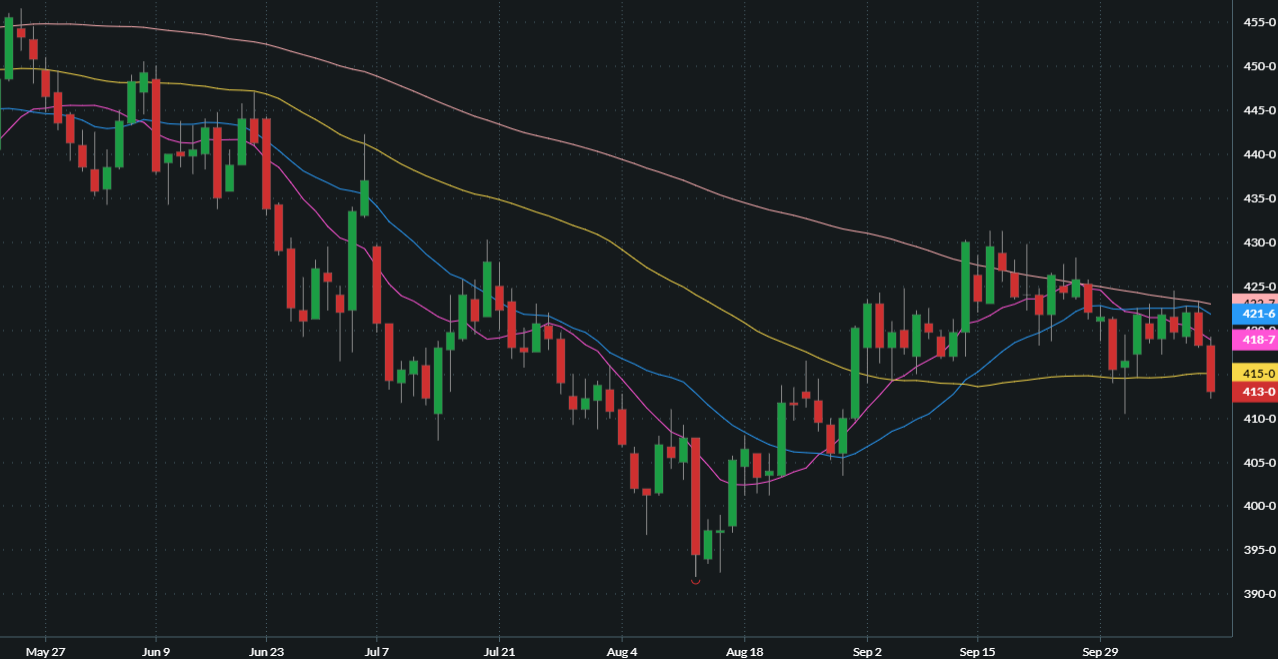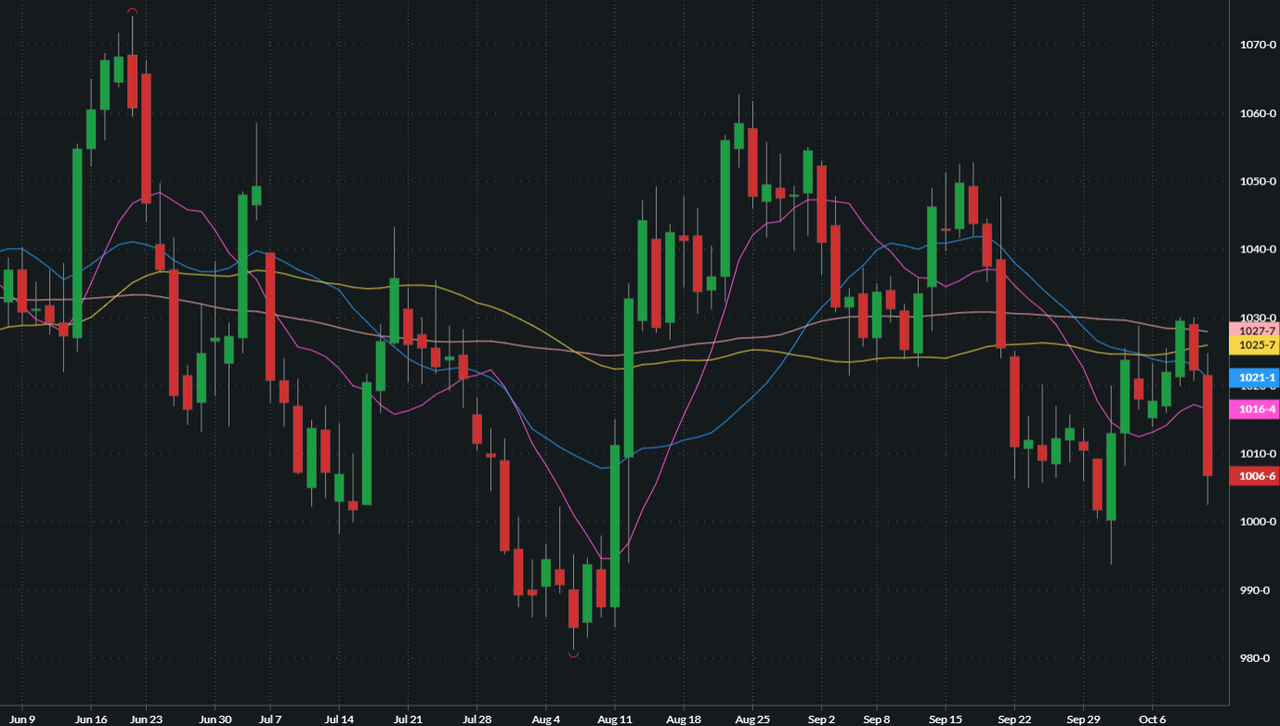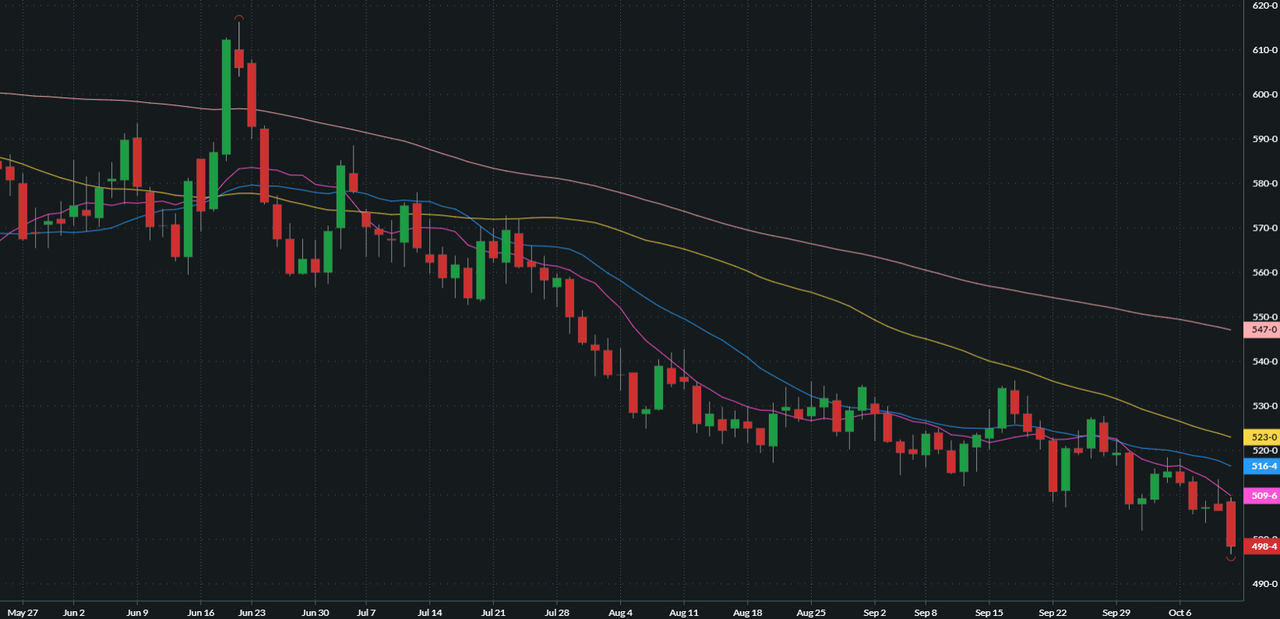Don’t miss the latest market commentary from the Farm Futures team. Sign up for the complimentary morning and afternoon market newsletters!
Prices updated as of 6:55 a.m. CDT.
What we’re watching
Facing another year of low corn prices, farmers across the Midwest are strategically filling bins and bags to weather the market downturn while waiting for better selling opportunities. “With these prices being so low, we’re going to store all that we can,” Nebraska farmer Josh England says.
Harvest pressure weighing on corn
December corn fell 0.25 cent to $4.1275 per bushel late in overnight trading after dropping 5.25 cents Friday to $4.13, the contract’s lowest settlement since August 28. Futures lost 2 cents last week for the market’s fourth consecutive weekly decline.
Corn technicals deteriorated late last week as the market extended a three-week downtrend drawn from December futures’ mid-September double-top high around $4.31 and closed above the 50-day simple moving average, currently about $4.15, for the first time since August 28. Prices found support overnight at Friday’s low of $4.1225 but remain near a five-week intraday low at $4.1050 posted October 1.
Near-term resistance comes in at the 10- and 20-day SMAs ($4.18 and $4.2125) and last week’s high at $4.2450.
Barchart’s front-month national average cash corn price fell about 5 cents Friday to $3.7075, down about 5.25 cents for the week.

Corn futures were dragged down with the soy complex on Friday after a social media post by President Trump exacerbated concerns over trade tensions with China. Pressure also arose from the accelerating U.S. harvest, with farmers believed to be making rapid progress amid mostly dry conditions across the Midwest.
Market concerns eased Sunday after Trump backtracked on his harsh China rhetoric, posting on Truth Social to “Don’t worry about China, it will all be fine!” Trump post followed Friday’s social missive threatening “massive” tariffs on China, saying the country was becoming “hostile” with its export controls on rare earth minerals.
Grain markets otherwise face another week with little fresh USDA data as the government shutdown continues, though weekly export inspections this morning may still be released. Analysts widely expect USDA to lower its record corn yield estimate, but the shutdown has increased the likelihood there will be no Crop Production update this month. Markets are also waiting for an expected announcement on a federal farmer bailout package.
The average U.S. corn yield is expected to be lowered to 185 bushels per acre from 186.7 bpa estimated in USDA’s September Crop Production report, based on a Reuters survey of analysts.
Despite the lack of USDA data, it’s still wise to keep an eye on the news. Total Farm Marketing’s Naomi Blohm says there are three market elements that could signal a potential bull market: cash basis, the U.S. dollar and fund traders. Read on in Naomi’s late Ag Marketing IQ column.
Soybean charts take a hit
November soybeans rose 2.25 cents to $10.09 late overnight after plunging 15.5 cents Friday to $10.0675, the contract’s lowest close since September 30. Futures fell 11.25 cents for the week to post a second straight weekly decline.
Soybean technicals took a hit with a late-week sell-off that sent November futures to the market’s first close below the 10-day SMA ($10.1625) since October 1. The poor performance suggests prices may have established a double-top high at $10.30 last week and could face further pressure this week. November futures managed a modest rebound overnight after holding above Friday’s low at $10.0250. Other downside levels to watch include the $10.10 and $10 areas, as well as the October low at $9.9375.
Barchart’s front-month national average cash soybean price fell about 15.75 cents Friday to $9.31, down about 9 cents for the week.

December soybean meal fell 20 cents to $274.80 per ton after sinking 1.3% last week for the market’s third weekly drop in the past four weeks. December soyoil rose 29 points to 50.26 cents per pound after easing slightly last week.
Futures posted a modest corrective rebound overnight but still face pressure from accelerating harvest, fading hopes for a federal farm bailout announcement and China’s absence of buying U.S. beans. Price downside may be limited by expectations USDA will slightly lower its forecast for a record U.S. soybean yield. The U.S. soybean harvest is believed to be near 50% complete.
Based on the Reuters survey, analysts on average estimate the average U.S. yield at about 53.2 bpa, down from USDA’s 53.5 bpa estimate last month but still a record. Production may be trimmed about 30 million bushels to 4.271 billion bushels.
Global soybean trade numbers underscore the difficult market facing farmers. Brazil exported a record 2.474 billion bushels of soybeans to China from January through August this year, based on data from Brazil’s Foreign Trade Secretariat. That represented 76% of Brazil’s total soybean exports during the period. In August alone, China purchased 290 million bushels from Brazil, setting a monthly record with an 85% share of Brazil’s soybean exports.
“China’s current share of Brazil’s soybean exports is historically high – comparable only to 2018, when President Trump launched the first trade war with China,” Purdue University economists Joana Colussi and Michael Langemeier said in a recent report. “The difference is that since then, Brazil’s soybean production surged by 40%, meaning the volumes involved today are far larger.”
Wheat sinks to new contract lows
December SRW wheat futures fell 2.5 cents to $4.96 late overnight after dropping to a contract low at $4.95. On Friday, prices sank 8 cents to $4.9850, a lifetime-low close and the lowest settlement for a most-active SRW contract since August 2020. Futures shed 16.75 cents last week for a fourth straight weekly drop.
December HRW futures fell 2.25 cents to $4.8075 after slipping to a contract low at $4.7950. December spring wheat fell 0.25 cent to $5.5150 and remain near a contract low posted Friday at $5.50.

Wheat futures remain under pressure as heavy bearish sentiment weighs on grain markets in the wake of a bigger-than-expected U.S. harvest. That’s overshadowing any bullishness over U.S. wheat exports that are running at a 12-year high.
Analysts expect U.S. wheat supplies at the end of the current marketing year will be higher than projected last month after USDA hiked its numbers for the winter harvest. Ending stocks for 2025-26 are seen rising to 875 million bushels from 844 million bushels in September, based on the Reuters survey.
Global wheat stockpiles at the close of 2025-26 may expand to 265.72 MMT (9.76 billion bushels) from the 264.06 MMT USDA forecast in September. The new estimate would be up about 1.3% from a nine-year low at the end of 2024-25.
Rainfall expected in Plains wheat areas this week may aid development of the recently-seeded crop.
Light rains ahead for western Corn Belt
Light rainfall is heading for the western Corn Belt and central Plains this week, with trace amounts to as much as 0.5 inch possible for Iowa, Kansas, Nebraska and the Dakotas today through Thursday, based on NOAA’s 72-hour precipitation map. The eastern Corn Belt is expected to remain dry.
Further ahead, the National Weather Service’s 6-to-10-day and 8-to-14-day outlooks continue to call for above-normal temperatures into late October. The 6-to-10-day outlook, which covers October 18-22, continues to shift wetter, calling for above-normal precipitation prospects expanding from the Plains across the entire Corn Belt. Indiana and Ohio now hold the greatest rain potential for that period.
Wall Street poised to bounce back sharply
Wall Street is poised to rebound from Friday’s sell-off after President Trump over the weekend eased his stance on tariff threats against China. Futures based on the S&P 500 index jumped over 1% while Nasdaq-100 futures surged 1.6%. On Friday, the underlying S&P 500 index tumbled 2.7% for its largest daily decline since April and posted a 2.4% drop for the week.
The U.S. dollar index rose about 0.1% after gaining 1.3% last week and posting a 2-1/2-month high on Thursday. Dollar strength last week was driven in part by political turmoil in France that burdened the euro.
November WTI crude oil futures rose 99 cents to $59.89 per barrel after sinking to the market’s lowest level in over four months on Friday. Gold futures rallied over 2.5% to a record above $4,100 per ounce behind continued safe-haven buying.
What else I’m reading at www.FarmFutures.com this morning:
Don’t wait until it’s too late to both have a solid succession plan and an understanding of federal estate tax policy. Ag law expert Rusty Rumley explains how a succession plan can help avoid headaches.